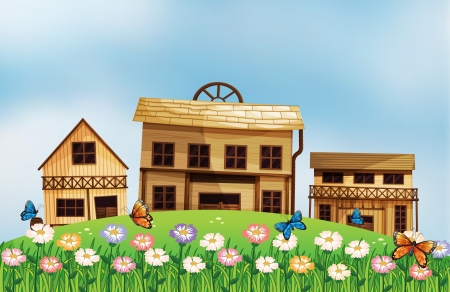1. Understanding Xeriscaping and Its Environmental Benefits
Xeriscaping is a landscaping approach that focuses on water conservation, making it an ideal solution for dry or drought-prone areas across the U.S. From the arid Southwest to parts of California and even some Midwestern states experiencing seasonal droughts, xeriscaping helps homeowners create beautiful, sustainable gardens that require minimal irrigation.
What Is Xeriscaping?
The term “xeriscape” comes from the Greek word “xeros,” meaning dry, combined with “landscape.” It refers to a style of gardening that reduces or eliminates the need for supplemental water from irrigation. Instead of traditional lawns that demand frequent watering, xeriscaped yards use native plants, efficient irrigation systems, and thoughtful design to thrive naturally in their environment.
Core Principles of Xeriscaping
Xeriscaping isnt just about using less water—its about working with nature to build a landscape thats both eco-friendly and visually appealing. Here are the seven core principles:
| Principle | Description |
|---|---|
| 1. Planning and Design | Create a detailed plan that considers climate, sun exposure, soil type, and existing vegetation to maximize efficiency. |
| 2. Soil Improvement | Add organic matter or mulch to improve soil texture, drainage, and ability to retain moisture. |
| 3. Efficient Irrigation | Use drip irrigation systems or soaker hoses to deliver water directly to plant roots with minimal waste. |
| 4. Appropriate Plant Selection | Select drought-tolerant native plants that are adapted to local conditions and support local wildlife. |
| 5. Mulching | Apply mulch around plants to reduce evaporation, suppress weeds, and regulate soil temperature. |
| 6. Turf Reduction | Minimize grassy areas by replacing them with groundcovers or hardscapes like gravel or pavers. |
| 7. Maintenance | Keep the garden healthy with regular pruning, weeding, and monitoring of irrigation systems. |
The Environmental Benefits of Xeriscaping
Xeriscaping offers several environmental advantages beyond just saving water:
- Water Conservation: Reduces outdoor water use by up to 60%, which is crucial in regions facing water shortages.
- Supports Local Ecosystems: Native plants provide food and habitat for pollinators like bees, butterflies, and birds.
- Lowers Maintenance Needs: With fewer lawn areas and more resilient plants, xeriscaped gardens require less mowing, fertilizing, and pest control.
- Cuts Down on Pollution: Less reliance on gas-powered lawn equipment and chemical fertilizers means cleaner air and soil.
Xeriscaping Across the U.S.
This landscaping method is especially beneficial in areas such as:
- The Southwest (Arizona, New Mexico)
- Southern California
- Certain parts of Texas
- Drought-prone zones in Colorado and Nevada
No matter where you live, adapting your yard using xeriscaping principles can lead to long-term savings on water bills while also creating a space that welcomes local wildlife—a perfect foundation for incorporating more wildlife-friendly features in your garden design.
2. Choosing Native and Drought-Tolerant Plants for Wildlife
Creating a wildlife-friendly xeriscape garden starts with picking the right plants—those that are both drought-tolerant and native to your region. These types of plants not only thrive in dry conditions but also provide essential food and shelter for local wildlife such as birds, bees, butterflies, and other pollinators.
Why Native Plants Matter
Native plants have evolved over time to adapt to local soil, climate, and ecosystems. They require less water and maintenance than non-native species and offer natural food sources for native animals. Using native plants helps support biodiversity and keeps your xeriscape low-maintenance.
Drought-Tolerant Plants That Attract Wildlife
The key is to choose plants that serve multiple purposes: they need to survive dry spells and also attract or support wildlife. Here’s a list of popular native and drought-tolerant plants categorized by the type of wildlife they benefit:
| Plant Name | US Region | Wildlife Supported | Main Benefit |
|---|---|---|---|
| Purple Coneflower (Echinacea purpurea) | Northeast, Midwest | Bees, Butterflies, Birds | Nectar-rich flowers; seeds for birds |
| California Poppy (Eschscholzia californica) | West Coast | Bees, Butterflies | Nectar source; low water needs |
| Mesa Gaillardia (Gaillardia x grandiflora) | Southeast, Southwest | Butterflies, Bees | Bright blooms; long flowering season |
| Muhly Grass (Muhlenbergia capillaris) | Southeast, South-Central | Shelter for small animals & insects | Drought-tolerant ground cover; visual interest |
| Conebush (Leucadendron spp.) | Southern California | Nesting habitat for birds | Tough shrub with year-round interest |
| Narrowleaf Milkweed (Asclepias fascicularis) | West Coast, Southwest | Monarch Butterflies, Bees | Caterpillar host plant; nectar source |
| Sagebrush (Artemisia tridentata) | Intermountain West, High Plains | Moths, Birds, Small Mammals | Aromatic foliage; erosion control; shelter plant |
Selecting Plants Based on Your Location
The U.S. has many diverse climate zones, from arid deserts to coastal plains. To ensure success with your xeriscape garden, its important to choose plants that are both native to your area and suited for drought conditions. You can check with local extension services or native plant societies in your state for region-specific recommendations.
A few resources to get started:
- Audubons Native Plant Database
- National Wildlife Federations Native Plant Finder
- Xerces Society Pollinator Resource Center
Create Layers in Your Garden Design
Diverse heights and layers in planting help mimic natural habitats. Use a mix of ground covers, shrubs, grasses, and flowering perennials to offer varied shelter and feeding options for different types of wildlife. For example:
| Layer Type | Example Plants | Wildlife Benefits |
|---|---|---|
| Ground Cover & Low Perennials | Creeping thyme, Yarrow, Desert marigold | Pollinator access; hiding spots for insects/small reptiles |
| Mid-Height Shrubs & Grasses | Blue grama grass, Black-eyed Susan | Nesting material; foraging zone |
| Tall Shrubs & Small Trees | Desert willow, Serviceberry | Bird nesting sites; shade & protection |
Add Diversity Over Time
You don’t need to transform your yard all at once. Start by adding a few well-chosen native plants each season. Over time, youll create a thriving ecosystem that supports local wildlife while staying water-wise.
![]()
3. Creating Shelter and Nesting Areas for Local Wildlife
One of the key ways to make your xeriscape garden more wildlife-friendly is by providing safe places for animals to rest, hide, and raise their young. In dry climates where water is limited, natural shelter becomes even more important for birds, insects, reptiles, and small mammals. Luckily, incorporating these features into your garden design can be both simple and beautiful.
Natural Elements That Provide Shelter
Using organic materials like rocks, logs, shrubs, and brush piles helps mimic the environment local wildlife naturally thrives in. These elements not only enhance the look of your xeriscape but also create micro-habitats that support beneficial species.
Common Materials and Their Benefits
| Material | Wildlife Benefits | Tips for Use |
|---|---|---|
| Rocks and Stone Piles | Create hiding spots for lizards, snakes, and insects; absorb heat for warmth | Place in sunny areas with space between rocks for easy access |
| Logs and Fallen Branches | Provide nesting areas for beetles and cover for small mammals | Use untreated wood and position partially in soil to encourage decay |
| Shrubs and Native Bushes | Shelter for birds; food source through berries or flowers | Select drought-tolerant native species that bloom at different times of year |
| Brush Piles | Nesting areas for birds; hiding spots for rabbits and other small animals | Layer twigs, sticks, and leaves loosely in a quiet corner of your yard |
Design Tips for Integrating Shelters Seamlessly
- Create variety: Mix different types of shelters throughout your garden to attract a wider range of wildlife.
- Avoid chemicals: Keep these areas free from pesticides or herbicides to ensure theyre safe havens.
- Think location: Place shelter elements near food sources like flowering plants or fruit-bearing shrubs to make them more functional.
- Add water if possible: Even a shallow bird bath or drip system can increase the appeal of your habitat zones.
By thoughtfully arranging natural elements in your xeriscape garden, you can create a welcoming space not just for people but also for the many creatures that call your region home.
4. Incorporating Water Sources in a Low-Water Garden
Even in a xeriscape garden designed to conserve water, its still possible to provide essential hydration for local wildlife. Birds, butterflies, bees, and other beneficial creatures need water to survive — and you can support them with small, efficient water features that won’t interfere with your low-water landscaping goals.
Choosing the Right Wildlife-Friendly Water Features
When selecting a water feature for your xeriscape garden, the key is to keep it simple, shallow, and easy to maintain. Here are a few popular options that work well in dry climates:
| Water Feature | Description | Wildlife Attracted | Water Usage |
|---|---|---|---|
| Birdbath | A shallow basin elevated off the ground; change water daily to keep it fresh. | Birds, bees, butterflies | Low |
| Drip Station | A slow-dripping hose or bottle over a rock or shallow dish; mimics natural dew or rain. | Bees, hummingbirds | Very Low |
| Shallow Basin on Ground | A ceramic or stone saucer placed at ground level with small rocks inside for perching. | Lizards, small mammals, insects | Low |
| Misting Rock Setup | A flat rock under a fine mist sprayer; provides hydration and cooling without pooling. | Butterflies, birds | Minimal (if timed) |
Placement Tips for Maximum Benefit
- Shade and Safety: Place water sources in shaded areas to prevent overheating and evaporation. Keep them near shrubs or native plants for cover so animals feel safe while drinking.
- Avoid Chemicals: Never use treated water or place features near areas sprayed with pesticides or fertilizers.
- Keep It Clean: Clean birdbaths and basins every few days with a scrub brush and plain water to prevent mosquito breeding and algae growth.
- Add Texture: Include pebbles or flat stones in dishes so insects and smaller animals can land safely without drowning.
Sustainability Meets Habitat Support
You don’t need a pond or fountain to attract wildlife. With thoughtful placement and minimal upkeep, even the smallest water features can make a big difference. By blending these wildlife-friendly additions into your xeriscape design, you create a thriving ecosystem without compromising on your commitment to water conservation.
5. Avoiding Pesticides and Using Eco-Friendly Maintenance Practices
Creating a xeriscape garden that supports local wildlife means thinking beyond just the plants you choose—it also involves how you care for them. Many traditional gardening products, especially chemical pesticides and fertilizers, can harm beneficial insects, birds, and other creatures that your wildlife-friendly garden is meant to support. Thankfully, there are safer, eco-friendly ways to maintain your landscape without disrupting the natural balance.
Why Avoid Chemical Pesticides?
Chemical pesticides dont just target pests—they can also harm pollinators like bees and butterflies, along with helpful insects such as ladybugs and praying mantises. These chemicals may even contaminate soil and water sources, affecting the broader ecosystem in your yard. By skipping synthetic pesticides, youre creating a safer environment for all living things, including pets and children.
Eco-Friendly Alternatives
There are many natural methods to control pests and keep your xeriscape garden thriving:
| Eco-Friendly Practice | Description |
|---|---|
| Companion Planting | Pair plants that naturally repel pests or attract beneficial insects. For example, planting marigolds near vegetables can help deter aphids. |
| Neem Oil Spray | A natural pesticide made from neem tree seeds; safe for most beneficial insects when used properly. |
| Diatomaceous Earth | A fine powder that dehydrates soft-bodied pests like slugs and ants without harming wildlife. |
| Hand-Picking | Remove larger pests like caterpillars or beetles by hand to avoid using any sprays at all. |
Natural Fertilizers and Soil Health
Healthy soil is key to a successful xeriscape garden. Instead of chemical fertilizers, try compost, worm castings, or organic soil amendments. These not only feed your plants but also improve soil structure and encourage beneficial microbes.
Benefits of Organic Fertilizers:
- Slow-release nutrients that reduce runoff into waterways
- Support long-term soil health and biodiversity
- No harmful residues left behind for animals or people
Watering Wisely
Even though xeriscaping focuses on low-water use, some watering is still necessary. Use drip irrigation or soaker hoses to target plant roots directly—this reduces water waste and avoids creating damp conditions that attract unwanted pests.
Create a Balanced Ecosystem
The best way to manage pests naturally is by encouraging a balanced ecosystem. Birds, frogs, ladybugs, and other beneficial creatures will help keep pest populations in check if given a safe space to thrive. Provide shelter like logs, rocks, or birdhouses and avoid disrupting their habitat with frequent raking or trimming.
Quick Tip:
If you ever need to use a product in your garden, look for labels marked “OMRI Listed” (Organic Materials Review Institute), which indicates the product is approved for organic gardening.
By choosing eco-friendly maintenance practices for your xeriscape garden, youre doing more than protecting plants—youre helping sustain a healthy outdoor environment where both flora and fauna can flourish.


